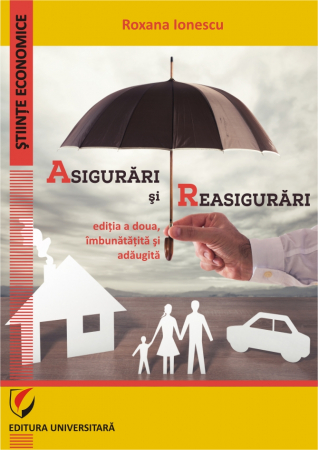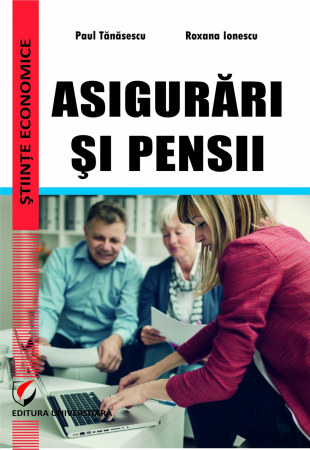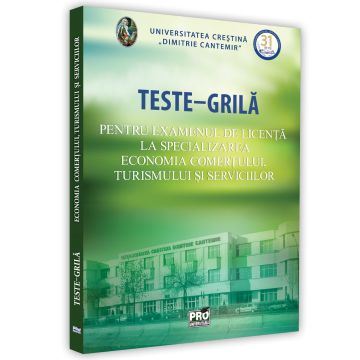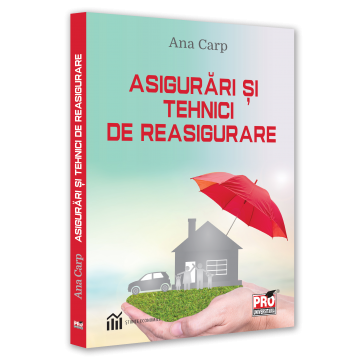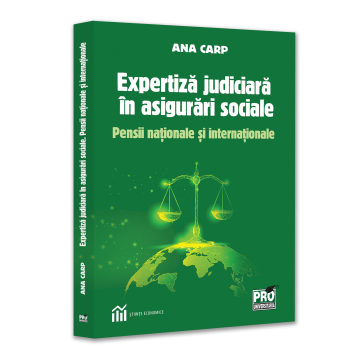6359.png) Set of books: Modern Insurance and Reinsurance. Theoretical-Methodological and Applied Aspects + Insurance and Reinsurance. Practical Workbook
Set of books: Modern Insurance and Reinsurance. Theoretical-Methodological and Applied Aspects + Insurance and Reinsurance. Practical Workbook
6359.png)
ISBN: 978-606-28-0810-5, 978-606-28-0992-8
DOI: 10.5682/9786062808105, 10.5682/9786062809928
Publisher year: 2018, 2019
Pages: 228
Publisher: Editura Universitară
Author: Roxana Arabela Dumitrascu
- Description
- Download (2)
- Authors
- Content
- More details
- Reviews (0)
Education:
Faculty of Economics, University "Petre Andrei" of Iasi, specializing in Finance and Accounting (2001);
Post-graduate School of the University FIBAS "Al. I. Cuza" Iasi, master's degree in Economics and Financial Management & Banking (2005);
Academy of Economic Studies (2010), PhD in Finance;
Romanian Academy, SPODE, post-doctoral studies in economics.
Activity:
2001-2011 professor at the Faculty of Economics of the University "Petre Andrei" of Iasi;
2012 Ph.D. Lecturer at the Faculty of Finance, Banking and Accounting, of Christian University "Dimitrie Cantemir" of Bucharest, owner of enterprise financial management courses, insurance and reinsurance and risk management in insurance and reinsurance.
Publications:
Single author: Financial management company. Self-study manual (2012), Insurance and reinsurance. Self-study manual (2012), Prices and and competitivity. Self-study manual (2012), Management of the goodwill value (2008).
Coauthor: Intangible firm capital management (2009), Drift Management (2005), Management versus postmodernity (2005), Defiance complexity (2004), Elements of evaluating companies (2002).
Over 70 articles and studies published in scientific journals.
Introduction / 9
CHAPTER 1
General notions regarding insurance
1.1. The evolution of insurance in Romania / 12
1.2. The concept of insurance / 16
1.3. Functions and role of insurance / 19
1.4. Questions and tests / 21
CHAPTER 2
Typology and institutional framework of insurance
2.1. Insurance classification / 24
2.2. Insurance companies and brokers / 30
2.3. Insurance regulatory framework / 34
2.4. Questions and tests / 39
CHAPTER 3
Elements specific to insurance
3.1. Subjects and object of insurance / 43
3.2. Insurance risk and insured interest / 44
3.3. Questions and tests / 48
CHAPTER 4
Financial dimensions specific to insurance
4.1. The insured amount and the insurance premium / 51
4.2. Damage, damage, damage and insurance indemnity / 53
4.3. Insurance period and territory covered / 54
4.4. Questions, tests and applications / 55
CHAPTER 5
Principles of damage coverage
5.1. The principle of proportional liability / 58
5.2. The principle of first risk / 59
5.3. The principle of limited liability (franchise clause) / 59
5.4. Finding and assessing damages. Establishment of compensations / 60
5.5. Questions, tests and applications / 65
CHAPTER 6
General characteristics of the insurance contract
6.1. Definition and characteristics of the insurance contract / 91
6.2. The principles underlying the conclusion and development of insurance contracts / 93
6.3. Steps in concluding the insurance contract / 94
6.4. Termination of the insurance contract / 96
6.5. Insured events / 97
6.6. Questions, tests and applications / 100
CHAPTER 7
The rights and obligations of the parties provided in the insurance contract
7.1. Rights and obligations of the insured / 108
7.2. The rights and obligations of the insurer / 109
7.3. Questions and tests / 111
CHAPTER 8
General notions regarding reinsurance
8.1. General considerations regarding reinsurance / 113
8.2. Basic characteristics of optional and contractual reinsurance / 115
8.3. Questions and tests / 119
CHAPTER 9
Compulsory reinsurance
9.1. Types of proportional compulsory reinsurance / 121
9.2. Types of non-proportional compulsory reinsurance / 124
9.3. Questions, tests and applications / 126
CHAPTER 10
Financial stability and solvency of the insurance company
10.1. The notion of financial stability of the insurance company / 142
10.2. Technical reserves - factor of stability and solvency of the insurance company / 144
10.3. Solvency margin of the insurance company / 147
10.4. Questions, tests and applications / 151
CHAPTER 11
Economic and social efficiency of insurance
11.1. The notion of economic-social efficiency of the insurance activity / 165
11.2. Indicators used to measure the economic and social efficiency of insurance / 166
11.3. Questions, tests and applications / 172
CHAPTER 12
Risk situations at the organizational level
12.1. Organizational risk multiplication factors / 179
12.2. Meanings and implications of risk at the organizational level / 181
12.3. Cyclical evolution of risk situations / 184
12.4. Organizational reactions to risk situations / 186
12.5. Questions and tests / 189
CHAPTER 13
Risk management in the field of insurance and reinsurance
13.1. The relationship between risk and insurance / 192
13.2. The notion of risk management / 195
13.3. Implementation of risk management systems / 198
13.4. Methods of risk transfer by insurance / 203
13.5. Ethics in insurance / 203
13.6. Questions and tests / 206
CHAPTER 14
Stages of risk management in insurance and reinsurance
14.1. Identifying the risks and uncertainties within the activity / 208
14.2. Risk assessment or quantification / 212
14.3. Risk control / 214
14.4. Questions, tests and applications / 219
Bibliography / 223
TABLE OF CONTENTS - Modern insurance and reinsurance. Practical workbook
PART 1
PRINCIPLES FOR COVERING DAMAGES / 7
PART 2
CO - INSURANCE AND REPAYMENT OF THE INSURED AMOUNT / 17
PART 3
INSURANCE CONTRACT / 27
PART 4
REINSURANCE CONTRACT / 32
PART 5
FINANCIAL STABILITY AND SOLVENCY INSURANCE COMPANY / 38
PART 6
ECONOMIC-SOCIAL EFFICIENCY OF INSURERS / 48
In this paper, insurance is approached, fundamentally, as precautionary measures, of a financial nature, for the preservation of certain assets, recovery of damages, protection of economic interests, protection of individuals, etc. As an economic process, insurances aim at the joint establishment by individuals and legal entities, through specific contributions, in the form of insurance premiums, of financial funds intended to cover damages that may occur as a result of uncertain but possible events. The main motivation of insurance consists in the objective existence of risks that may manifest in the future (probable events), with the potential to cause damages. The insurance intervenes between the insured and the insurer, usually a specialized institution, which undertakes to compensate him in exchange for the event (risk) in exchange for the insurance premiums, paid periodically by the insured. The insurance premiums paid by the insured depend on the size of the insured amount and the nature of the risk. The insurance relations that intervene between the economic agents become more and more complex as the area and the type of insured risks expand.
As the insurance and reinsurance activity aims to provide financial protection mechanisms against a wide range of potential hazards, the approach of identification, analysis, quantification and risk assessment is an essential component of this business area. The risk study provides analytical and informational support for the design of insurance products and policies promoted by insurance companies. The offer and strategies of insurance companies result directly from the thorough, rigorous and systematic study of the entire range of possible risks that may affect the activity and integrity of different customer segments. In this way, risk management is the conceptual and methodological core on which the operations carried out in the insurance sector are based.
The insurance and reinsurance business represents the economic sector which, among other things, has the difficult function of taking over and absorbing the risks from the other areas of the economy. Another function of maximum importance assumed by insurance and reinsurance refers to the attenuation of discrepancies and inconsistencies too accentuated that appear periodically between real economic cycles and financial cycles. Within this sector, the "underground" tendencies are externalized, hidden from superficial or formal observations, outlining the main economic, financial or other risks. It turns out that insurance, as a "risk taker", forms an absolutely indispensable support mechanism for the normal functioning of the market economy. The efficiency of insurance and reinsurance is the direct expression of the level of uncertainty that characterizes the economy, manifesting a high degree of sensitivity to variations in random and unpredictable phenomena.
The insurance field is closely interrelated with the investment one, as the collection of substantial financial funds in order to protect against presumptive dangers requires, by respecting the principle of rationality, the alternative use of these funds as a result of judicious capitalization of beneficial opportunities identified on financial markets. Also, modern insurances are characterized by a meticulous legal regulation and by an extremely wide range of products and services. The last two aspects transform insurance and reinsurance into a field of systematic and rigorous knowledge, with its own methodological arsenal.
The profound structural changes that have taken place in the world economy, as well as in the national one - globalization, dematerialization, deregulation, sectoral relocations, deepening of the crisis, etc. - urge us to look critically not only at decision-making practices at different organizational levels of the economy. inspired them. These mutations exert particularly pressing effects in the sense of re-examining the theoretical concepts and models in most financial sciences. Insurance and reinsurance not only are not an exception, but, on the contrary, are at the forefront of this conceptual renewal, as it is the field that has taken on the mission of answering some fundamental questions:
What is currently the risk and, consequently, the feasibility of an economic, social or personal construction?
What are the main factors (inducers) of risks in modern society?
What are the means of protection against the tendency to multiply the risks?
Of course, the issue of insurance and reinsurance is much more complex, but we must recognize that the other concerns are, directly or indirectly, only derivatives subordinated to these three crucial issues, and the sharpness of the economic crisis forces us to revise, sometimes even radically, traditional perspectives on them.
We intend that the work we have elaborated should be constituted even if only in a modest contribution to the exploration of this issue, as rich as it is important for the competitiveness and economic consistency of a country.
This paper aims as a major objective to present to students and masters the main theoretical notions and practical tools on types and contracts of insurance, insurance market operation, insurance supervision, estimation and management of insurance risks, insurance company management. One of the subordinated objectives is the complete information of the students and master students regarding the communication mode and the mechanisms of integration of the domestic insurance market in the international markets. In the same vein, the aim will be to familiarize readers with the main national and international regulations on insurance and reinsurance. Learning the models and techniques of analysis and management specific to the field of insurance and reinsurance is another point of maximum interest targeted by the authors. The paper focuses on a systematic and interdisciplinary presentation of the fundamental conceptual and methodological aspects that shape the field of modern insurance and reinsurance.
Assoc. Dr. Roxana Arabela Dumitrascu

![Set of books: Modern Insurance and Reinsurance. Theoretical-Methodological and Applied Aspects + Insurance and Reinsurance. Practical Workbook [1] Set of books: Modern Insurance and Reinsurance. Theoretical-Methodological and Applied Aspects + Insurance and Reinsurance. Practical Workbook [1]](https://gomagcdn.ro/domains/editurauniversitara.ro/files/product/large/set-of-books-modern-insurance-and-reinsurance-theoretical-methodological-and-applied-aspects-insurance-and-reinsurance-practical-workbook-237-5369.png)
